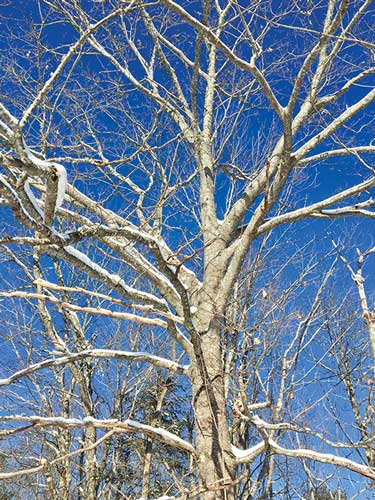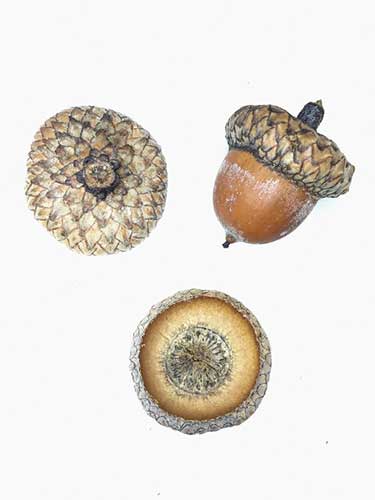 |
| Current climate change projections predict that Maine will become increasingly hospitable to red oak. English photo |
 |
| Red oak acorns. English photo |
By Noah Gleason-Hart
As Hannah Murray outlined in her winter 2018 article in The MOF&G, with foresight, planning and commitment, our forests have a large role to play in mitigating the effects of climate change. However, even as we work to increase the carbon sequestration and storage potential of our woodlots, we have an obligation to proactively consider adaptation strategies that ensure the health and resilience of our forests in a changing world. Introducing tree species projected to do well in a changing climate, commonly called assisted migration, is one strategy small woodlot owners should consider.
As Maine’s climate changes, conditions may become less conducive to the health and growth of some of the species Maine is known for, such as red spruce (Picea rubens), while other species, such as shagbark hickory (Carya ovata), may find a new niche. Species’ ranges naturally move in response to these shifts in climate and site condition, and trees likely are already making their way farther north in Maine. However, as climate change accelerates and forested landscapes become more fragmented, trees may no longer be able to move fast enough to react to new conditions, according to Williams and Dumroese in “Planning the Future’s Forests with Assisted Migration” (2016. In these cases judicious tree planting can improve forest resilience, either by increasing the abundance of a species already present and expected to do well in the future, or by introducing more southerly species to new areas.
A perfect example of the former might be planting more northern red oaks (Quercus rubra) in central and northern Maine. Red oaks are native here and are most common in southern parts of Maine but are found throughout the state. Current climate change projections predict that Maine will become increasingly hospitable to red oak, according to “Tree Atlas Coastal and East Maine and the Northern Forest” (2015), so planting seedlings in northern forests, where they are not yet common, may ensure a robust seed source for the future.
The great of advantage of assisted migration to forest stewards is that it requires no significant investment, expertise or equipment to carry out on a small scale – just relatively inexpensive tree seedlings, a shovel, and some forethought about species and site location. Even better, you don’t need a large lot to join this effort; even a few trees in a large backyard can serve as a seed source for surrounding lots and wood edges.
The “Climate Change Tree Atlas” for 134 forest tree species of the Eastern United States, from the U.S. Forest Service is a powerful tool as you consider which tree species to plant in your woodlot or yard. The atlas calculates the vulnerability of individual species to climate change and projects the amount of suitable habitat for that species in a given state based on climate change scenarios of varying severities. After studying the atlas to find species projected to do well statewide, learn about the characteristics of your own land to determine what might do well on your site. Take a hike to identify what species you already have, look at the amount of sunlight available and the topography of your land, and read about the quality of your specific soils. When in doubt, consider consulting your forester, who should know your land intimately and can recommend trees that are not yet present in your local area but that could do well on your land. If you don’t have a forester yet, you may want to reach out to your Maine Forest Service district forester, who, for no fee, can share information and resources and provide a list of local private foresters.
Once you decide which tree species you would like to introduce, find a source of robust planting stock. Maine does not have its own state nursery, but the New Hampshire State Forest Nursery (https://www.nh.gov/nhnursery/) carries a strong selection of bareroot seedlings, and many of Maine’s Soil and Water Conservation Districts offer quality seedlings at reasonable prices. New England also has many reputable, private nurseries. Nurseries do not always advertise their growing practices, so if this is important to you, be sure to ask.
To ensure adequate light for your seedlings, consider planting in an old field you would like to see return to forest, in a canopy gap caused by several blown-down trees, or after a harvest. If you plant in an open field, you may need to weed whack around the trees for the first several years. In a forest planting, cut faster growing stump sprouts and pioneer species that threaten to overtop your seedlings. If your goal is to harvest some of the trees you plant, especially hardwoods for saw logs, allow significant competition when trees are young to encourage upward growth and self-pruning butt logs. If your goal is instead to grow seed-producing trees as rapidly as possible, give them plenty of room; they’ll grow large, robust crowns and bear seed quickly.
Participating in assisted migration on your land does carry some risk. Perhaps most importantly, you may introduce a species that aggressively outcompetes native trees and reduces biodiversity, or otherwise disrupts complex ecosystems. To mitigate this risk, choose species native to New England, consult local experts on species selection and monitor plantings closely. You will also lose some of your transplants to dry springs and herbivore damage, or because your site may not be suitable for species you selected. That’s just part of planting trees.
Finally, climate change projections are predictions based on sound science, not guarantees, so view them as a guide rather than as a roadmap. For example, don’t cut all of your hemlock (Tsuga canadensis) simply because projections show a reduction in suitable habitat, and don’t plant a monoculture of sweet birch (Betula lenta) based on positive growth projections. Instead, you may want to keep hemlock as a component of your woods but also plant some sweet birch. Diversity is the key to a resilient forest.
If you decide to introduce new trees to your land, now is the time to talk to your forester, hike through your woods to find suitable planting sites and order seedlings. Tree planting season will be here soon!
For more about assisted migration, see Handler, S.; Pike, C.; St. Clair, B.; 2018. Assisted Migration. USDA Forest Service Climate Change Resource Center.
To learn about proper planting techniques, see Planting and Care of Tree Seedlings from UNH Cooperative Extension.
Noah Gleason-Hart is MOFGA’s low-impact forestry specialist. You can contact him at [email protected].
